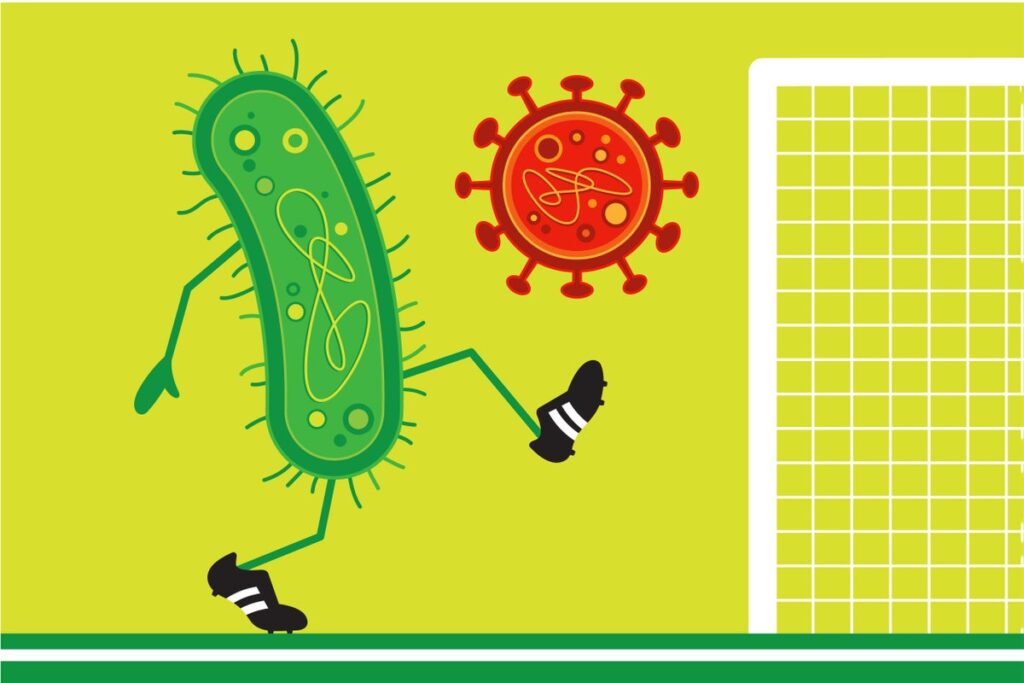October 9, 2025
3 min read
Bacteria Use Viral Naps to Build Immunity
New research shows how microbes use napping viruses to vaccinate themselves
The idea that a single-celled bacterium can defend itself against viruses in a similar way as the 1.8-trillion-cell human immune system is still “mind-blowing” for molecular biologist Joshua Modell of Johns Hopkins University.
Scientists discovered 20 years ago that bacteria use an adaptive defense system called CRISPR that allows microbes to recognize and destroy viral invaders on repeat encounters. In a recent study published in Cell Host & Microbe, Modell and his team have deepened our understanding of how bacteria use this system to “vaccinate” themselves against phages, the viruses that try to kill them. The findings could help the development of treatments to fight antimicrobial resistance, which contributes to millions of deaths annually.
The CRISPR system allows bacteria to edit their own genome. After being exposed to a virus, bacteria can use a special enzyme to insert small pieces of the virus’s DNA, called spacers, into their genome, which helps them recognize and fight off the virus next time. Scientists now use this enzyme as a pair of “genetic scissors” to tweak DNA in everything from lab experiments to gene therapies, but researchers still knew little about how this process plays out in bacteria. “We called it the CRISPR mystery because we didn’t really understand what was happening inside,” Modell says.
On supporting science journalism
If you’re enjoying this article, consider supporting our award-winning journalism by subscribing. By purchasing a subscription you are helping to ensure the future of impactful stories about the discoveries and ideas shaping our world today.
To understand how bacteria manage to grab the DNA of invading viruses, the researchers ran controlled lab experiments using Streptococcus pyogenes bacteria and the phages that infect it. During the infectious phase, most phages rupture the cell immediately, a process known as lysis. On rare occasions, they can instead hide inside the bacterial DNA and become dormant, a state called lysogeny. This state is notoriously difficult to study.
In the lab, Modell’s team infected bacteria with phages that could go dormant as well as genetically engineered phages locked in an active state. The researchers then collected surviving cells and checked their genetic code to see if they had added new spacers taken from the viruses’ DNA.
They found that bacteria only added spacers from phages that could go dormant. During this lull, Modell explains, the bacteria have time to grab tiny pieces of viral DNA and store them in their genome. “The CRISPR system makes memories against an inactivated form of the virus just like a vaccine,” Modell says. To confirm their results, Modell and his team exposed spacer-carrying bacteria to the same phages again to observe whether the new genetic memories protected them from infection. The researchers observed that the bacterium can recognize the phages using those stored fragments and fight them off.
The findings are “pretty remarkable,” says molecular biologist Stan Brouns of Delft University of Technology in the Netherlands, who was not involved in the study. Understanding the interactions between phages and bacteria is key to improving phage therapies, an approach where scientists use viruses to treat infections caused by bacteria that have developed resistance to antibiotics.
This new understanding could also help researchers design phages that more types of infection-causing bacteria will be susceptible to, says North Carolina State University molecular biologist Rodolphe Barrangou, who co-founded Locus Biosciences, a biotech company that develops antibacterial products, and who also was not involved in the study. Various bacteria can have any of more than 150 antiphage defense mechanisms that treatments have to dodge; understanding how this one works is “going to inspire people who work on [bacteria] to think about phage therapies on a broader range of infectious diseases.”
It’s Time to Stand Up for Science
If you enjoyed this article, I’d like to ask for your support. Scientific American has served as an advocate for science and industry for 180 years, and right now may be the most critical moment in that two-century history.
I’ve been a Scientific American subscriber since I was 12 years old, and it helped shape the way I look at the world. SciAm always educates and delights me, and inspires a sense of awe for our vast, beautiful universe. I hope it does that for you, too.
If you subscribe to Scientific American, you help ensure that our coverage is centered on meaningful research and discovery; that we have the resources to report on the decisions that threaten labs across the U.S.; and that we support both budding and working scientists at a time when the value of science itself too often goes unrecognized.
In return, you get essential news, captivating podcasts, brilliant infographics, can’t-miss newsletters, must-watch videos, challenging games, and the science world’s best writing and reporting. You can even gift someone a subscription.
There has never been a more important time for us to stand up and show why science matters. I hope you’ll support us in that mission.

